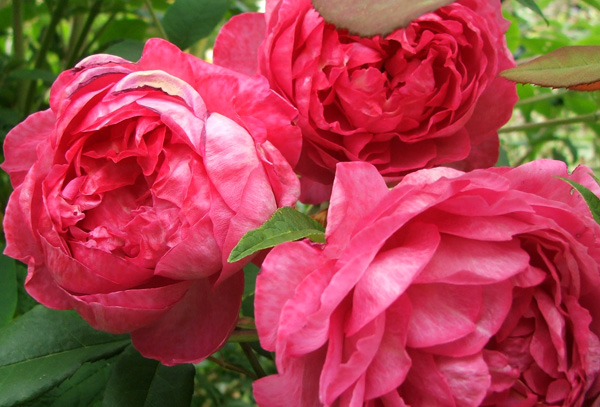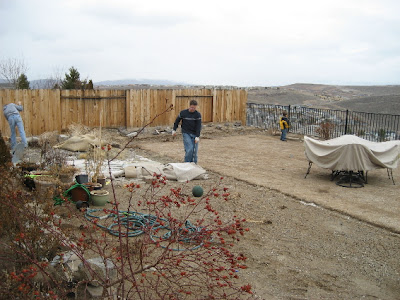If I had to trace this tendency back to some starting point, I’d probably end up in high school. Maybe even junior high. That’s when I realized that brand-name clothing was cool, and that my closet was conspicuously devoid of it.
Remember that iconic Jordache horse? Never galloped its way onto my teenage derriere. I longed for, but never wore, Esprit’s breezy horizontal lines. And that Guess question mark ever lent my 80s-era outfits that certain je ne sais quoi . My parents simply didn’t go in for that sort of rubbish. They had other, weird, grown-up priorities like paying the mortgage and figuring out how to get three meals out of one chicken.
No matter. Now that I’m grown-up, too, I understand my parents’ priorities, and I also can’t help compensating for those early deprivations in little ways. I don’t buy BCBG dresses or Prada sunglasses. No, I pamper myself with ‘May Night’ salvia, and ‘Hot Summer’ Echinacea.
But most of all, with David Austin Roses.
 |
| davidaustin.com |
Oh, those David Austin roses. I don’t know what it is about them. At the risk of sounding like a paid advertisement, they are, for me, the floral embodiment of abundance. The blooms evoke generosity, and warmth, and plenty. When I see pictures of them on the David Austin website, it makes me wish I were small enough to curl up inside a fluffy bloom and have a nap.
 |
| St. Swithun |
 |
| Lady Emma Hamilton |
 |
| Princess Alexandra of Kent |
See what I mean? Unlike the stiff, pointy, hybrid tea roses I grew up around, Austin’s English roses have a lush, blousy decadence that recall antique roses-- without the diseases and short bloom period that often accompanied them. For some, they may recall grannies and kittens and doilies. For me, they are pure cottage garden charm.
What happened to my devotion to drought tolerance, you might ask? Dear reader, I ask you to permit me this deviation (and perhaps a few others down the road). You’re right. Roses are, as a rule, a little thirstier than my beloved gauras and yarrows. But what they require in water they give back in wanton beauty and pure work ethic.
In fact, many repeat-blooming roses will grace your garden with color and fragrance, almost continuously, from early summer until frost. You could say they have an exceedingly high Wow to Water ratio. So I make an exception. Or, more accurately, I just can’t help myself. Roses must have a place in my garden.
Unfortunately, the above photo doesn’t capture the rose’s captivating habit of becoming suffused with delicate pink as it ages. Here’s a better photo from marcjamesmuseum.com:
Though I can’t remember how much those beauties cost me, today it’s hard to buy an Austin rose at a nursery without swiping at least $45 onto your card. So when I received their catalog in the mail this year offering bare root roses for closer to $22, I placed my order for three shrubs.
One, naturally was a Molineux, for a spot near the backyard fence. For the plot of earth against the back of our house, right underneath our living room window, I chose two in contrasting shades of pink. One is named Benjamin Britten (after the British Composer).
 |
| Courtesy of mooseyscountrygarden.com |
The other is called Strawberry Hill (named after a Gothic revival style house in the U.K.).


The roses should grow tall enough to offer a glimpse of blooms through the window, but not so tall as to crowd the glass. After placing my order back in April, I cheerfully awaited the arrival of my shrubs. The box didn’t disappoint.
But I imagine anyone unfamiliar with bare root plants may have been shocked and disappointed with the contents. To be blunt, bare root roses look like the Ugly Stick we hear about people being hit with.
Planting these babies required some preparation and effort. First, soaking for several hours in water.
Then I dropped the plants in, perching the spray of roots on a pyramid of dirt and compost at the bottom of the hole.
Once they were tucked in, there was almost nothing left to see. Here is Sir Benjamin Britten:
Pretty stark, right? I, too, had my doubts as to whether these sticks were going to wake up. But then…about six weeks later…TA DA!
That’s the Strawberry Hill with his
And here are some of the blooms we’ve gotten so far.
 |
| Molineux |
 |
| Strawberry Hill |
That one doesn’t look much like the catalog pictures yet, huh?
And here’s a pair of pictures of Benjamin Britten, first partially open, then in the final stage of bloom.
 |
| Benjamin Britten |
 |
| Benjamin Britten |
Here are Sir Benjamin and Strawberry Hill with the 'Ivory Halo' variegated dogwood bush I planted in the center of the bed for contrast.
Finally, here are the three roses in our full-color garden scheme with arrows pointing to each one: M=Molineux, B.B.=Benjamin Britten, S.H.=Stawberry Hill.The Strawberry Hill, so far, has a rather odd growth habit, with some stems heading straight up, and all of the flowers ending up face down in the mulch.
Ah well, it's early yet. With a little luck, the photos I post next June will chase away my current doubts and worries. If not, we’ll just have to enjoy the ‘Pierre de Ronsard,' a.k.a. 'Eden,' climbing roses I found at a nursery shortly after I purchased the D.A. roses. This rose was introduced in France by Meilland in 1987. Here's ours, while still in its container:
Ahhhhhhhh... Nap, anyone?
















































